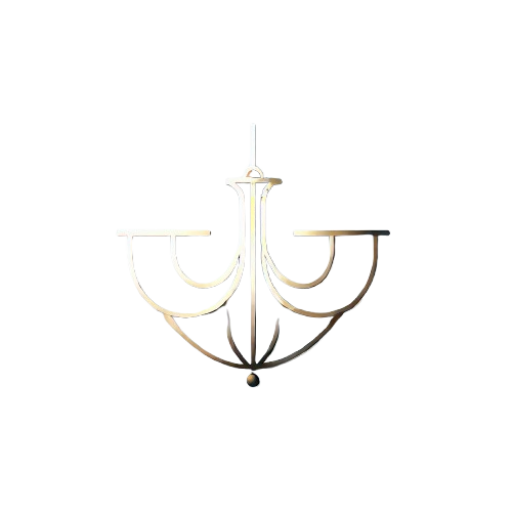Whether you’re looking for a light to make your home more convivial, your dining room or incorporate character into a different room in your home, chandeliers happen to be relevant choices.
There are many styles of chandelier to choose from. These include modern, contemporary and traditional chandeliers. In addition to materials, there are several other aspects to consider when choosing a chandelier. These include size, light output, type of light source, dimming options and much more.
Here are our tips for finding the chandelier that will be ideal for your decor.
What should I look for when searching for my ideal chandelier?
Apart from style, there are three factors to consider when selecting a chandelier which are: size, direction of light emission and control.
A chandelier with the wrong size could impact on the look of space given by a room. For example, an 80cm high chandelier suspended in the middle of a room with a 2.5m ceiling could give the impression that it is extremely low. When in doubt, it’s best to err on the side of the largest size, as chandeliers are statement pieces.

Use the ‘rule of thumb’ below to customise your chandelier to be the focal point of the room (if it’s not installed above a table or counter).
Measure the length and width of the room in m. Add these two numbers together. The sum of these two numbers should equal the diameter of your chandelier in cm.
This is just a guide, but it’s a starting point. Try our chandelier sizing tool to easily find the right chandelier size for your space.
You also need to make sure the light coming out of the fixture isn’t glaring. There’s nothing worse than sitting at the dining room table with the glow of a bright bulb in your face.
Where does the light go? Are the bulbs hidden or exposed? If the bulbs are exposed, you should consider adding a dimmer to the chandelier to control the light output.
If I’m going for a modern or contemporary look, which lighting trends should I focus on?
For a more modern look and design, choose satin nickel or chrome finishes. Bronze finishes are more common in transitional lighting, which combines traditional and modern design elements.
Modern designs tend towards chrome and satin nickel. Also look for clean lines and minimal decoration. Remember that the finishes and materials of the chandelier should also complement the other finishes in your space.
How big should my chandelier be in my dining room?
Chandeliers are sized according to their diameter and height. The number of bulbs can also affect the size. I recommend that the diameter of the chandelier should be half to two-thirds the width of the dining room table. The average dining room chandelier today has four to six bulbs and measures between 65 and 75 cm in diameter.
Before buying, please also consider the height of the ceiling and the height of the chandelier. The chandelier should be hung at a distance of 76 to 91 cm between the top of the table and the bottom of the luminaire. A chandelier that is too high will almost fall on the table top! However, if the ceiling is high, a two- or three-tier model can be very effective.
Will my chandelier be bright enough to light the whole room? How much light should I really expect from my chandelier?
Chandeliers are decorative lights designed to add style and atmosphere. Therefore, don’t expect your chandelier to become the main source of light in the room.
This is one of the biggest mistakes you can make when using a chandelier. Placing a single light fixture in the centre of the room and expecting it to fully illuminate the room is the secret to insufficient light. If the bulbs of the chandelier are exposed, this problem will become more severe, which is common in many chandeliers.
The chandelier works best as an auxiliary light source, but is best if incorporated into a layered lighting system.
For example, incorporating built-in cans, wall shelf lighting or wall sconces into the room is a great way to enhance the space and show off the walls, paintings, plants etc. Countertops and cabinets.
Are there chandeliers that use modern technologies such as LED?
Absolutely! Contemporary lighting designers and manufacturers are launching incredible new LED chandeliers every day. LED technology has advanced so much that you often can’t tell the difference between LED lamps and traditional incandescent lamps.
Even better: some people now prefer to use LEDs because they offer truly unique design possibilities! LEDs are so small that designers don’t have to worry about hiding the light source. This means more freedom to experiment with form, function and materials.
As well as design flexibility, other benefits of LED lighting include increased efficiency and reliability, resulting in significant energy and cost savings.
LEDs are five times slower than halogen lamps, consuming 1/5 the energy. LEDs also have a longer life than other light sources, with an expected life of around 50,000 hours or 25 years of use for 5 hours a day.
If I buy an LED chandelier, will I be able to lower it to create a romantic atmosphere?
When paired with compatible low-voltage dimmers, many LED pendant lights are fully dimmable, but not all LED pendant lights are dimmable, so you should ask yourself before you buy.
Check the specifications of each fixture, then check the manufacturer’s recommendations for a compatible dimmer. Not all dimmers can be used with all lamps.
Can I replace my current chandelier with an LED or CFL (compact fluorescent lamp) without having to replace the fixture?
Upgrading a chandelier to use LEDs or CFLs is called an “upgrade” and is often, but not always, possible.
It depends on the luminaire. There are many LED and CFL bulbs that can be bought for replacement, but be aware that the light output may vary. If your chandelier is connected to a dimmer, you will probably need to buy a new dimmer that is compatible with your CFL or LED bulbs. Remember that the dimmer adjusts the intensity of the bulbs, not the fixture.
Plumen is a decorative and fun compact fluorescent lamp that works well in fixtures where the bulb is visible, but the downside is that it can’t be adjusted. When it comes to a dimmable compact fluorescent, I like this Bulbrite but would only recommend it if the bulb is not exposed in the fixture.
Keep in mind that if your chandelier bulbs are exposed, there are LED lights and compact fluorescents that can work but can also look horrible. If you want to install a compact fluorescent or LED light, buy a single bulb to see if you like it. Then, if you want to, replace the rest.
Can I use a chandelier in a room other than the dining room?
Of course! Chandeliers are usually found in hallways and formal entrances, kitchens, living rooms, bedrooms and even bathrooms or toilets.
Again, where to install the chandelier depends on the size of the room, the height of the ceiling, the size of the fixture and the surrounding décor. They can go anywhere!
Can I hang a chandelier over a dining table even if the electrical box isn’t centred on the table?
Yes. As a general rule, one of the two solutions below will work. If you have drywall ceilings, an electrician can move the junction box to centre it on the table.
This isn’t a simple operation as you also need to plaster the old hole in the ceiling. If you have concrete ceilings, the chandelier can be placed in the centre of the table. This means that the hook must be centred on the table to hang the wires from the junction box to the suspension hook. You can also use a cable cover on the ceiling to hide the appearance of the cable.
How high should I hang my chandelier?
In the dining room, the aim is to hang it low enough not to dazzle the light source, but high enough not to obstruct vision. A good rule of thumb is to hang the chandelier so that the bottom of the light is 76 to 91 cm from the top of the table. Adjust the height according to your preference or the requirements of the room.
Are there any other factors I should consider when choosing a chandelier?
Sometimes it’s better to have the unexpected than to go for a ‘safe’ look. Just make sure you love it!




